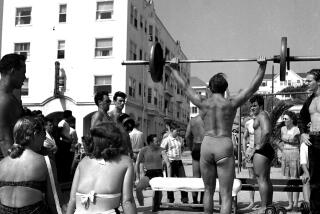Poor Lack Means to Exercise, Survey Says : Health: The less people earn, the more likely they are to say that their neighborhood is unsafe for workouts, poll finds.
- Share via
WASHINGTON — It isn’t a lack of knowledge that keeps poor people from exercising as much as wealthier ones. It’s a lack of means, a survey indicates.
Both lower- and higher-income Americans share an understanding that burning calories off by exercise is more beneficial for weight control than starving them off by dieting, the survey said. The poll was done for former Surgeon General C. Everett Koop’s health promotion group, Shape Up America.
But poor people face major obstacles to exercise, the survey found. They often don’t feel safe exercising outdoors in their neighborhoods, don’t have public facilities to go to even if safety were not an issue, and can’t afford private facilities, it said.
The national telephone poll of 1,599 urban residents was done by Yankelovich Partners of Claremont, Calif. Forty-seven percent had family incomes of less than $25,000.
A large proportion, 31%, was nonwhite. This was an attempt to offset a common problem in polls--that they have enough whites to reflect majority opinions accurately but not enough minority respondents.
A lack of opportunity to exercise may be a key reason why poorer people are more likely to be overweight, said Barbara Moore, Shape Up America’s executive director.
More of the poorer respondents considered their neighborhoods too unsafe for them to exercise, including walking or jogging, Moore said. Of respondents in families who earned less than $25,000, 26.2% felt this way, compared to 14.5% in families who earned more.
“The lower your income, the more likely safety is to be an issue,” More said. When income dropped below $15,000 a year, 30.6% were concerned about safety.
Money was another obstacle; 46.5% of those in families earning less than $25,000 felt they could not afford recreational facilities, while only 23% of those in families making $25,000 or more did.
More public access to school facilities such as high school gyms might be a way to solve this problem. “Any existing facility needs to be viewed as an asset to public health,” Moore said.
Attitudes toward exercise were similar on both sides of the income line, said Hal Quinley of Yankelovich Partners.
When asked to compare the importance of physical activity and dieting as ways to control weight, 59% of the lower-income group ranked exercise first and 15% put dieting first, Quinley said. In the higher-income group, 58% ranked physical activity first and 13% favored dieting, he said. The differences are statistically meaningless, he said.
Also, 28% of the $25,000-plus group reported trying to increase the amount of exercise they did, while 24% of the lower-income group did--fairly similar proportions, Quinley said.
The finding that safety is an issue nationally fits with one survey done in Atlanta’s Kirkwood community, said Carl J. Caspersen, a physical activity epidemiologist with the federal Centers for Disease Control and Prevention in Atlanta. Safety was a major issue there, he said.
Shape Up America wants to encourage people to exercise. But exercise may not be a big issue in poor communities, Caspersen said. “The other viewpoint is, ‘This is a war zone and exercise is the least of my concerns,’ ” he said.
More to Read
Sign up for Essential California
The most important California stories and recommendations in your inbox every morning.
You may occasionally receive promotional content from the Los Angeles Times.












